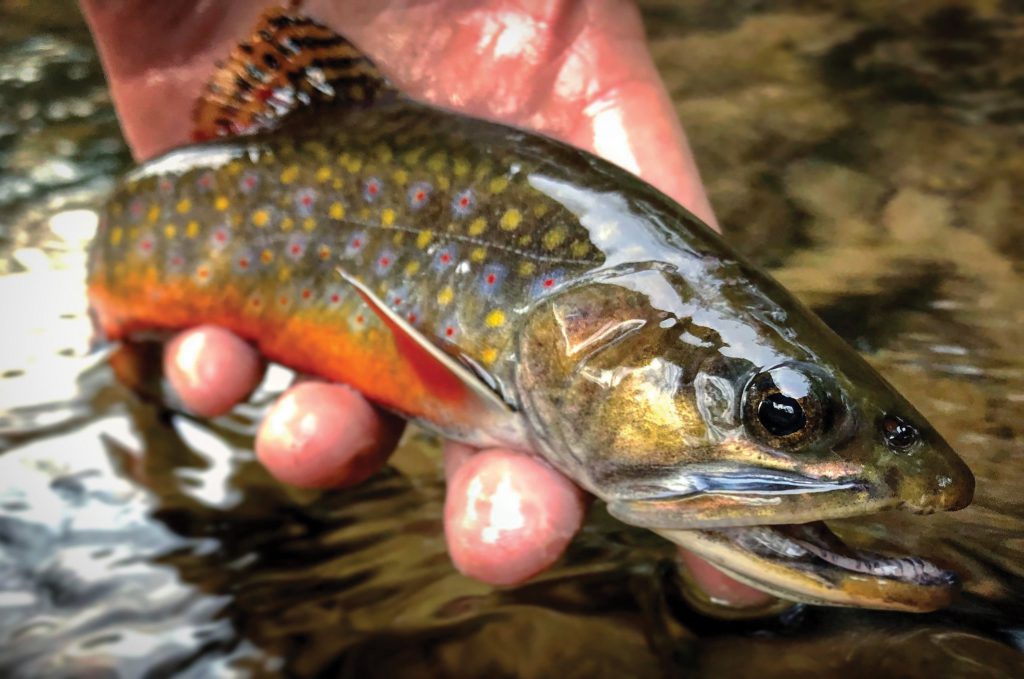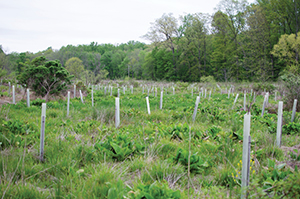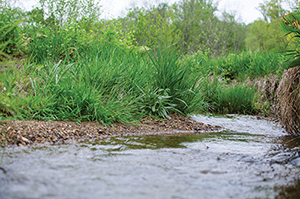From Forests to Fish: Brook Trout Resurgence is Made in the Shade
The land and the water are connected in so many ways, and many of these connections are unseen or little known. What washes off the land surrounding waterways, from manure to fertilizer to soil particles with traces of chemicals–even at a microscopic level–can have long-lasting impacts on a variety of species inhabiting Maryland waters.
Planting trees and shrubs to catch and absorb this runoff and reduce nutrient inputs into our streams has been proven to be effective over time, as has been shown by Maryland Forest Service data collected from stream-side forests, or riparian forest buffers. It is the forests of our state that are filters for our waters and our air, creating a healthier habitat for wildlife and humans alike. Acting as a sink for all those nutrients and sediment, the collective root systems of a forest stand stabilize an eroding landscape and sequester copious amounts of rainfall and the runoff byproduct that comes with it.
One of the simpler benefits, or ecosystem services, that our native forests provide is shade. Any person who has stood in a scorching, sunbaked lawn with nothing but turf and not a tree in sight can appreciate the cool respite a tree canopy provides. That same refuge we seek on a hot day is what the native trout of Maryland, the brook trout, depend upon for survival in streams throughout the state; making the establishment of streamside forests, or riparian forest buffers, pivotal for restoring one of Maryland’s iconic native wildlife species.
Fish’s Tale
Spawning and migration of brook trout are all tied to water temperatures, and our only native trout in much of the eastern United States is the perfect environmental indicator as it survives in only the coldest, cleanest waters, no warmer than 68 degrees.
A brook trout’s journey begins as a fry, or baby fish, hatched in spring from an egg its mother laid in the autumn–ideally on a gravel streambed cleared of silt near the lower end of a stream pool. This baby brookie’s home is called a redd. The fry will emerge sometime between February and April, based on water temperatures, seeking refuge in vegetated areas or protected pockets of a streambed.
Maturity is usually reached at age two, with overall lifespan averaging about five years. Depending on its stage of life, a brook trout will be quite specific in its habitat selection; temperature, dissolved oxygen and food availability are some driving factors. Whether through shading with canopy, nutrient uptake by trees to prevent degraded oxygen, or streamside vegetation and resulting leaf litter supporting insects that feed fish, building forests along our waterways can help address all of those factors.
Even when it comes to the subsurface, trees and trout are interconnected from root to redd. Forest stands effectively slow down infiltration of groundwater, helping to conserve and manage the hydrology and water budget, or change in water storage, of the land. The gravel depressions where eggs are laid can be heavily influenced by ground-water recharge from below the streambed.
Crucial Collaboration
Efforts to increase forest buffer plantings and tree canopy while rebuilding brook trout habitat include a multitude of organizations, such as Maryland Trout Unlimited, Chesapeake Bay Foundation, Maryland Department of Natural Resources (both Fishing and Boating Services and Maryland Forest Service), U.S. Department of Agriculture Natural Resources Conservation Service (NRCS), local county Soil Conservation Districts, and Alliance for the Chesapeake Bay. However, the most important partners in all of this are landowners invested in the long-term health of their woods and water.
Considering that about three quarters of the state’s forests are in private hands and only 11% of all brook trout streams and stream miles are fully within state land, the cooperation and collaboration between government agencies and private citizens in habitat restoration efforts is crucial to any success. Part of that success is linked to introducing the public to the alphabet soup of planting programs available to them, including Maryland’s Conservation Reserve Enhancement Program (CREP), which is designed to benefit the landowner and the land.
One of those landowners is Greg Dell of Manchester, whose property borders an unnamed tributary of Big Pipe Creek in an area that’s part of the Upper Monocacy River watershed. Dell’s land has been in the family and farmed for 50 years. When he took ownership of the property in 2015, the pasture on the land had been neglected for approximately 8 years, and prior to that was in a no-till crop rotation of corn and soy.
After talking to his local Soil Conservation District office, Dell said he realized that going through CREP to install a forest buffer would be perfect for restoring the waterway and land on his 154-acre property. Through the combined efforts of the NRCS and DNR watershed forester Jamie Weaver, 27 acres of native trees and shrubs were planted along Dell’s waterfront property in spring 2016.
Just a few years of growth later amid an emerging forest canopy, the tributary winding through this newly reforested land provided quite a surprise. A fisheries survey completed last summer by DNR Fisheries Manager Mark Staley and fellow staff found brook trout of several age classes throughout the mile stretch of waterway in Dell’s restored pastureland, a previously undocumented stream regarding brook trout populations. “The age class diversity suggests that a small stream like this, with a still developing forest canopy, is capable of supporting trout nurseries,” according to Weaver.
For the past three years, Staley and staff have been surveying numerous streams throughout the state and particularly outside of the Upper Gunpowder watershed to determine new streams capable of supporting brook trout. Just adjacent to the Gunpowder watershed is Greg Dell’s property and stream, where one of at least three previously undocumented populations was identified during this survey. “We were excited to learn brook trout were in this stream considering they are pretty scarce in Central Maryland, and this population appears to be really healthy,” exclaimed Staley. Carroll County Soil Conservation District staff familiar with these waters suggest that while these brook trout may be a new discovery to surveyors, the trout have been there all along, leftovers from when they were common in that part of the state.
This fisheries discovery showed “a very robust population” living in Dell’s stream, according to Scott Scarfone of Maryland Trout Unlimited’s Upper Gunpowder Brook Trout Partnership. “We’re all ecstatic,” Staley said, pointing out that this population was not stocked. “They have been existing there for who knows how long!”
Not only is Dell’s growing streamside forest creating brook trout habitat, but additional stream improvements through the Alliance for the Chesapeake Bay’s Buffer Incentive Payment program were just as vital in restoring his waterway and brook habitat. The Buffer Incentive Program, funded through a National Fish and Wildlife Fund grant and managed by the Alliance, rewarded landowners enrolled in planting programs with additional funding to address other land restoration priorities.
Using a combination of funds from the Alliance’s program and NRCS’ Environmental Quality Incentives Program, Dell was able to replace an old bridge impeding fish passage with a new one that improved brook trout migration. Craig Highfield, the director of the Alliance’s Forestry Program, pointed to the work between his organization, the Maryland Forest Service, NRCS and soil conservation districts on this project as “one of their real success stories.” The restoration of land and water and the re-establishment of brook trout habitat are “all happening with the great partnerships between all of our agencies” and the Buffer Incentive Program addressing the stream crossing “helped seal the deal, pushing this project across the finish line,” said Highfield.
This surprise stream of brookies was made even more special when a couple of the brook trout were measured close to the 10-12 inch range, considered maximum size at maturity.
Making this restoration project particularly vital to trout habitat restoration is the fact that the second largest population in Maryland exists along the northern tier of rural northern Carroll and Baltimore counties. Outside of Garrett County, 82% of brook trout streams in the state are classified by DNR as “greatly reduced,” upping the stakes for trout in watersheds such as the Upper Gunpowder and Upper Monocacy. The nearest known brook trout population is about four miles away in the Gunpowder River watershed, making this newly documented population the only brook trout stream on the eastern side of the Monocacy watershed, according to Staley. Maintaining genetic diversity is an important factor in preserving a keystone native species like our brook trout. “They would need to swim a lot of stream miles to get to their nearest neighbor,” Staley said.
In a shrinking natural landscape bordered by aggressive development and agriculture-dominated parcels, protecting and preserving this environmentally sensitive species in a densely populated region of the state is vital and can be accomplished as shown by this recent fisheries find in a young, growing forest. Having a landowner witness firsthand the connection between stream restoration and habitat creation, including planting a forest buffer, can only help preserve the vital habitat of Maryland’s brook trout.
dnr.maryland.gov/forests
Francis Smith is a Natural Resources Planner with the Maryland Forest Service.Article appears in Vol. 23, No. 2 of the Maryland Natural Resource magazine, summer 2020.





 1-888-373-7888
1-888-373-7888 233733
233733